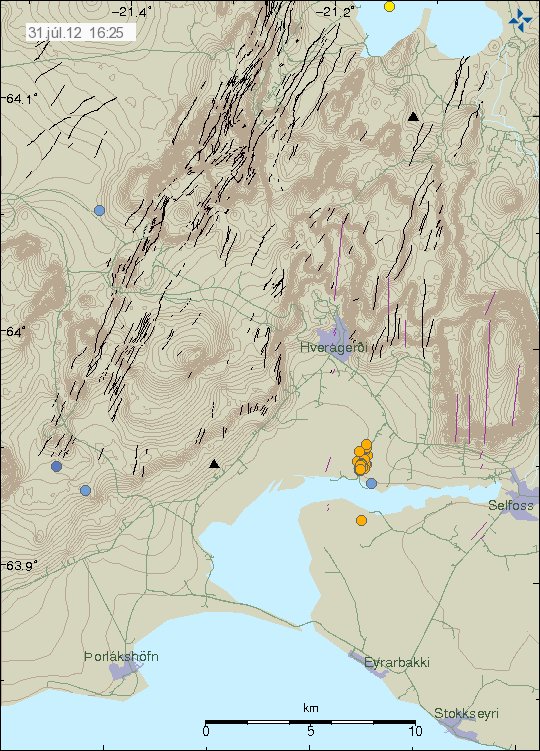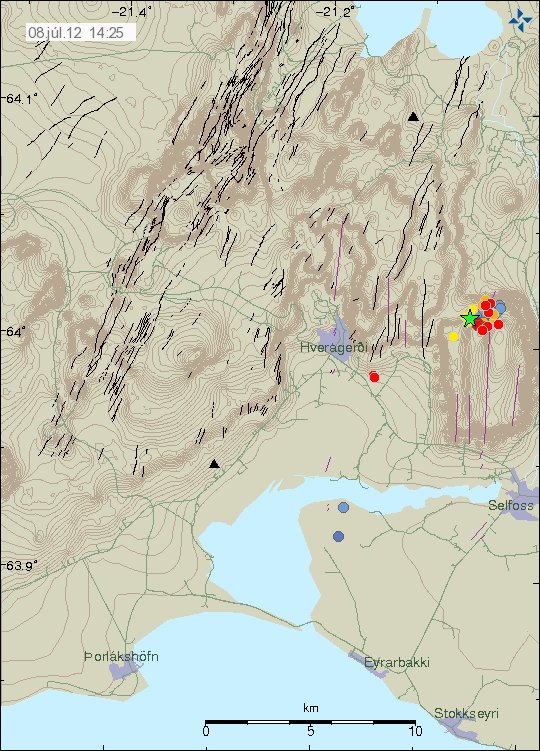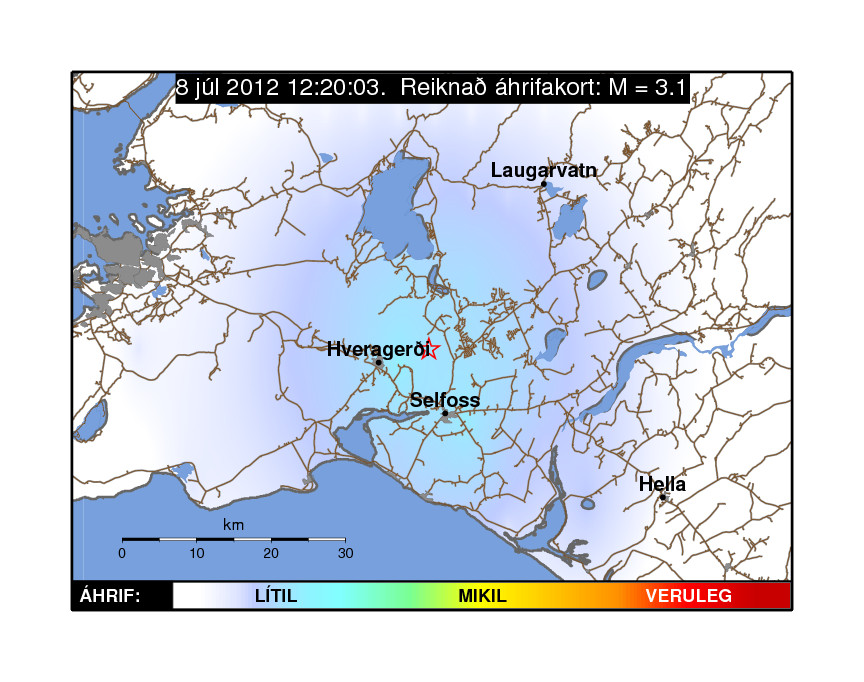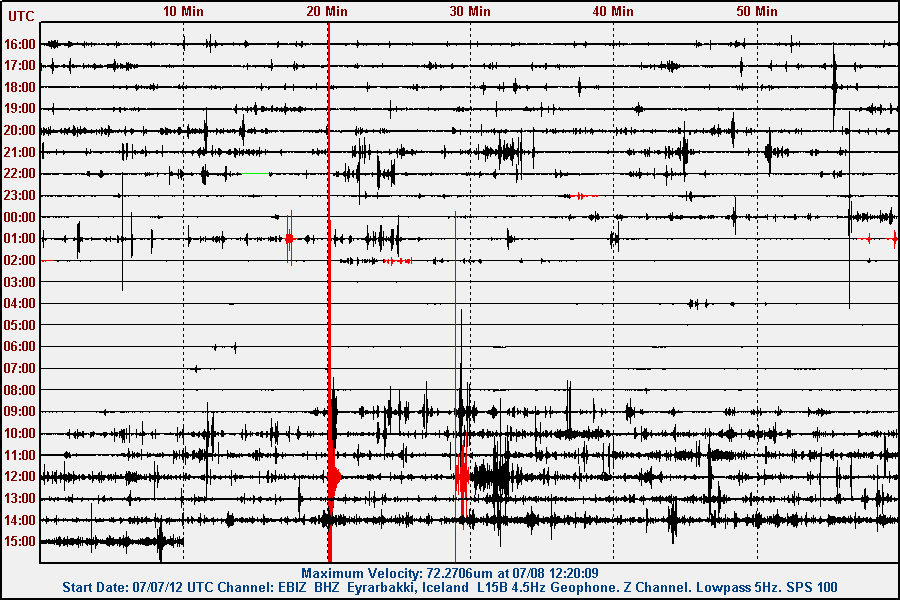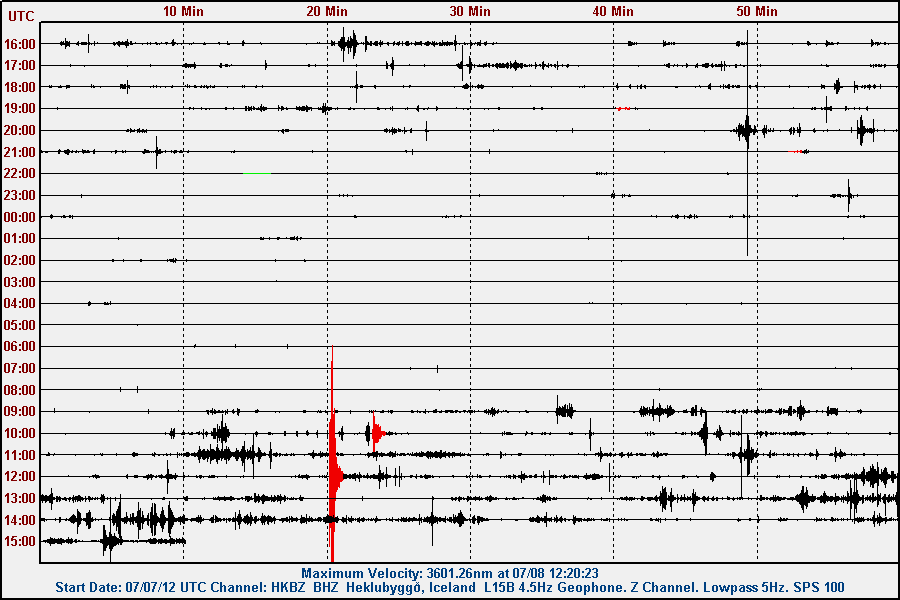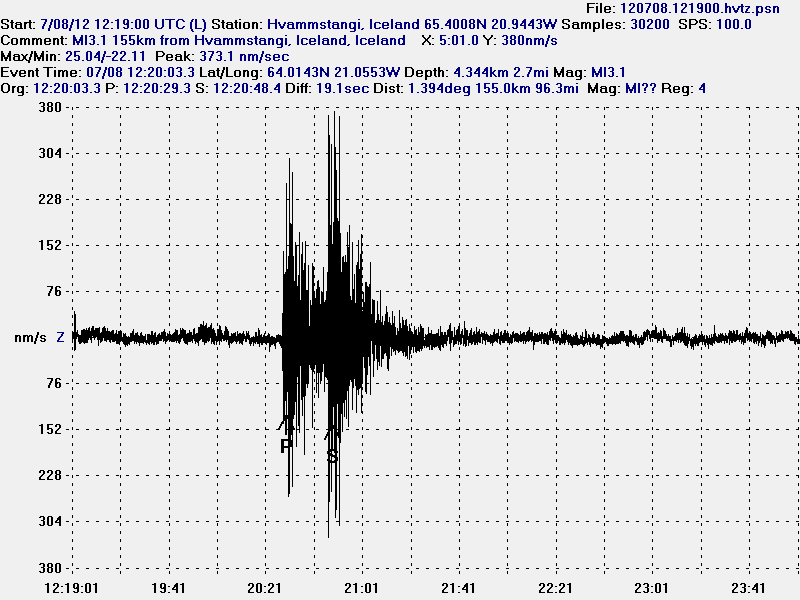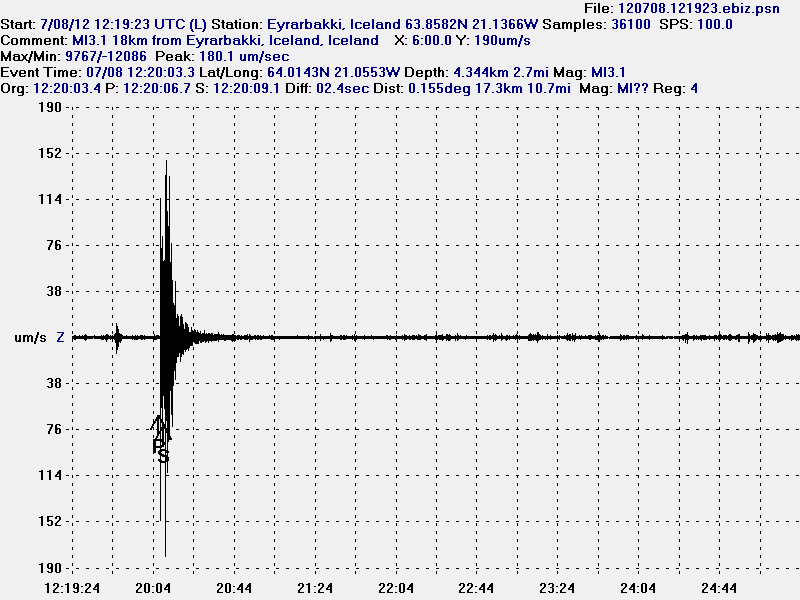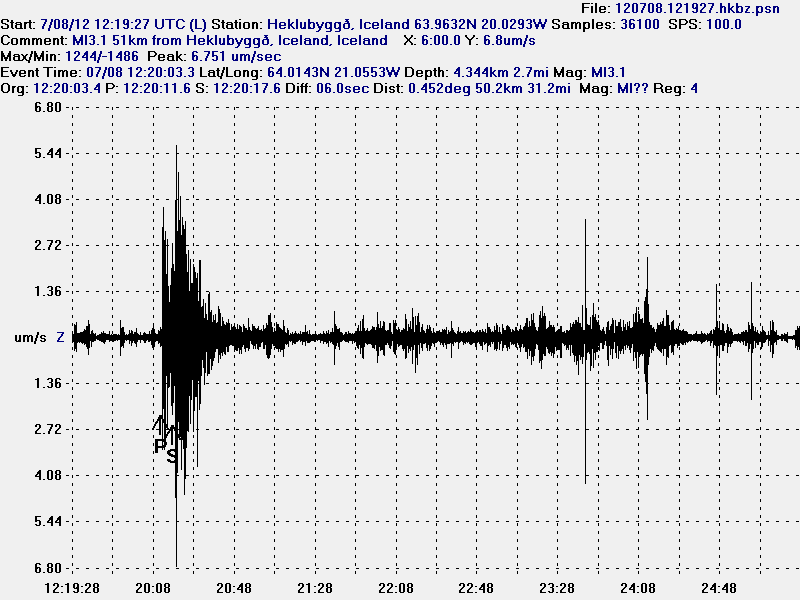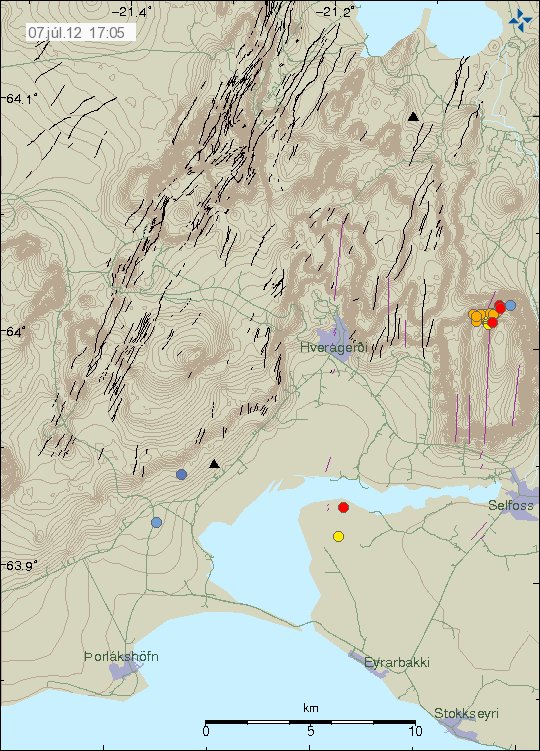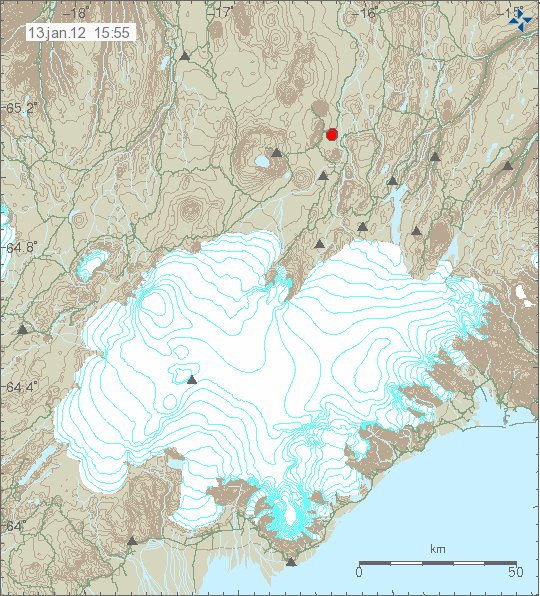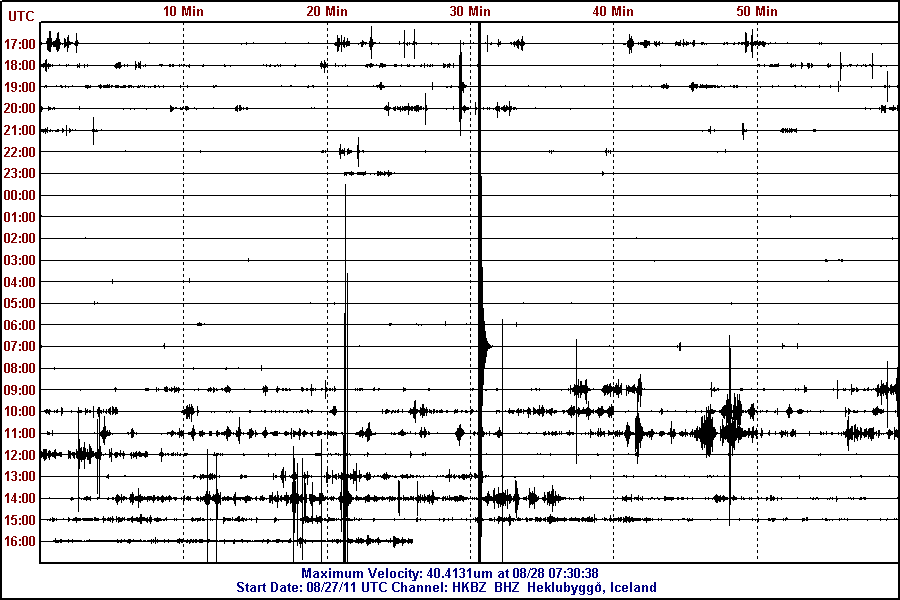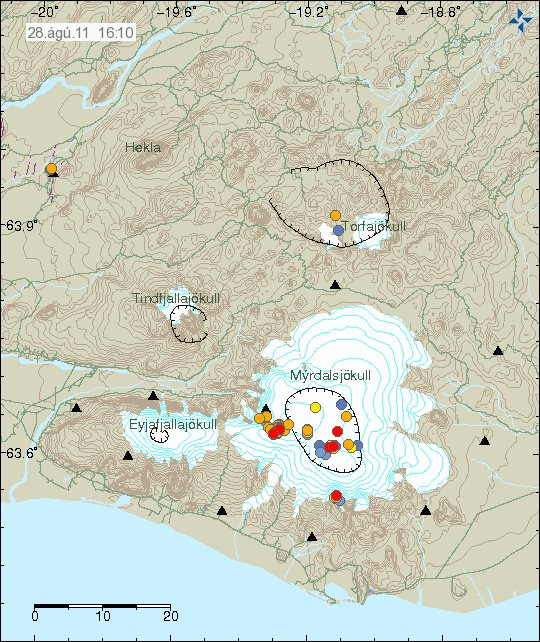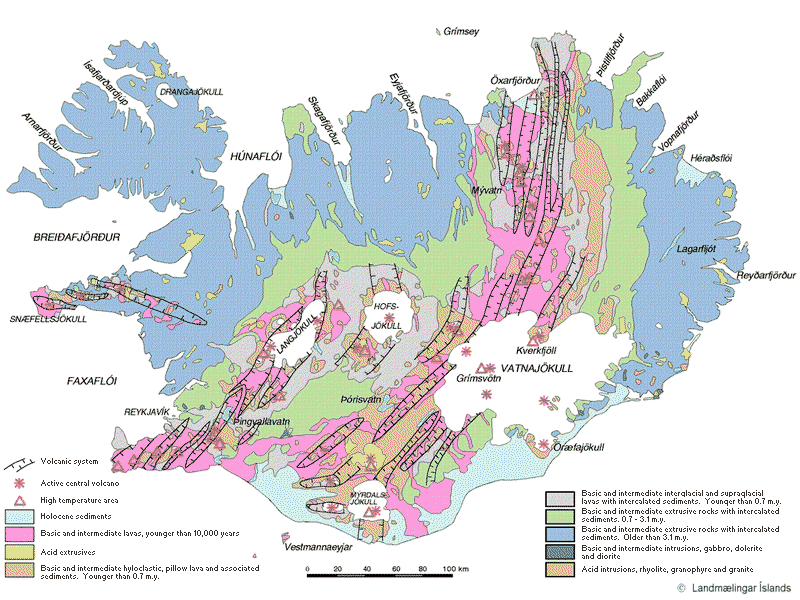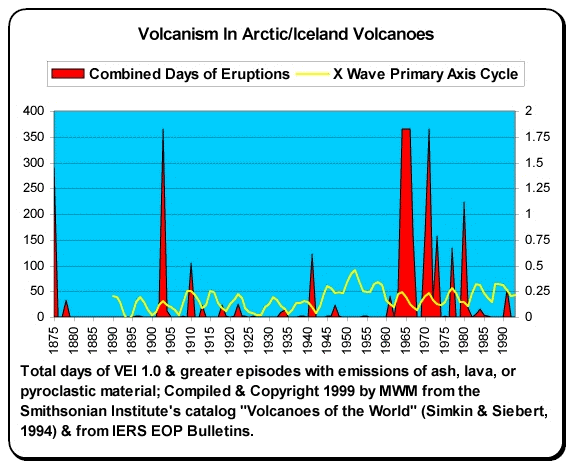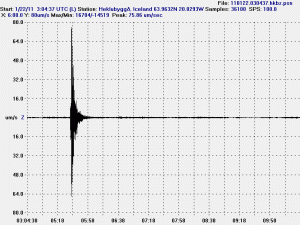Here is a short overview of the activity on the South Icelandic Seismic Zone (SISZ) since Icelanders started to document it’s activity history. The oldest record of a large earthquake on SISZ is from the year 1103. In most cases it is not clear how large earthquakes are. But it was not until early 20th century when recording of earthquakes started it became clear how big the earthquakes in SISZ can really be. The average break between earthquake swarms in SISZ is from 1 year and up to 90 years.
Earthquake year.
Year 1103. A earthquake hits SISZ. It is not documented where. But 11 people died in that earthquake.
Year 1169. A earthquake hits Grímsnes. Total death was 19 people.
Year 1182. A earthquake kills 11 people. It is unclear where this earthquake did happen and how big it was.
Year 1211. A earthquake collapses many houses and kills 18 people. This earthquake took place 7th July.
Year 1294. A eruption in Hekla volcano and it is followed by many large earthquakes in SISZ. The hydrothermal activity increased in this earthquakes due to the earthquakes. It is believed that Geysir did form in this earthquake swarm in SISZ.
Year 1308. A large earthquake hits. Many houses collapse. Six people did die.
Year 1311. A large earthquakes hit on 10th and 11th of January. A total of 18 houses collapsed and 16 people died in this earthquakes.
Year 1339. A large earthquakes hit on 22nd of May. Witness account says that people where not able to stand up during the earthquake. Most collapse of houses did happen in Flóa, Holtamannahrepp and in places between Þjórsá and Eystri Rangár. Rockfall was witnessed following this earthquakes. A hydrothermal activity appeared in a mountain named Henglafjöllum (at that time) where none had been before.
Year 1370. A large earthquake south of Ölfus. A total of 12 houses collapse and six people did die in this earthquake.
Year 1389. Large earthquakes take place. Increased hydrothermal activity in Geysir area. New hot spring forms in that area.
Year 1391. A large earthquake takes place south of Grímsnes, Flóa and Ölfus. A total of 14 houses collapse and some so badly that they where totally destroyed. Water did flow from the ground following this earthquake. Only few people did die. They where sad as poor and the number it is not sad how many they where.
The gap between 1391 and too the year 1546 is most likely due to loss of historical documents. Not because there was a lack of earthquakes in SISZ during that time.
Year 1546. A large earthquake happens in SISZ. He is mostly noted in Ölfusi. A unknown number of houses collapsed. Nobody did die in this earthquake.
Year 1581. Earthquake did hit SISZ on the 30th of May around 03:00 local time (04:00 GMT modern time ?). Many houses collapsed during this earthquakes. Many people did die in this earthquake. In one instance is a death of a woman and here two year old kid is documented to have happened during this earthquake. Unconfirmed news from that time period say that that nine people died for east part of south Iceland and a large cracks did form in the ground because of the earthquake.
Year 1613. A earthquake hits. Date is not documented. A “mountain” is sad to have collapsed on Skeiðum and something called “reiðningstorfa” was outside a house. It did vanish during the earthquake and was never seen again. For the record. I have no idea what “reiðningstorfa” is. So don’t even try to ask me on it. I have no clue what so ever about this.
Year 1618. A large earthquake swarm hit SISZ. Earthquake hit SISZ all hours of the day. In one earthquake four houses collapsed and there was a formation of cracks so big that people where not able to cross over them.
Year 1624. A swarm of earthquake took place. Two houses collapsed. Human fatalities are not documented.
Year 1630. The winter that year a total of three earthquakes did happen. It did kill six people and collapsed unknown number of houses. The strongest earthquake took place on the 21st of February. A new fissures and cracks did form in the ground. The Geysir hydrothermal area did see large changes. New hot springs formed while others did dry up. Close to Skálhot fissures did open that both people and animals did fall into and die. They where also sad impossible to cross over.
Year 1633. Earthquake swarm hits SISZ,. Houses collapse in Ölfusi. Nothing more is documented.
Year 1657. A earthquake swarm both on SISZ and western part of Iceland (?). Two houses collapsed in this earthquake. But no human died in this earthquake swarm. On the 16th of March a earthquake did happen in Fljótshlíð and it did collapse many houses.
Year 1658. Earthquake swarm took place there between second and third day of Easter that year.
Year 1663. Many earthquakes in Reykjanes Peninsula did destroy many houses. Water levels in Kleifarvatn did drop. The water did flow into fissures that formed during the earthquakes. The water level dropped 300 feets. So that was once under water was now on dry land.
Year 1671. A earthquakes took place during the summer in Grímsnes and Ölfusi. But it is not documented if any damage took place during this earthquake swarm.
Year 1706. Large earthquakes take place this year. The first earthquakes takes place on the 28th of January. But the most earthquake takes place on the 20th of April when 24 houses collapsed. At least one person did die during this earthquake swarm. A loss was in live stock that did die during this earthquake swarm. This earthquake swarm lasted until spring. But was least noticed in western part of SISZ.
Year 1732. On the 7th of September a large earthquake took place in the area of Rangárvellir. This earthquake did damage 40 houses and 11 did collapse in the earthquake. Four people got hurt. But nobody did die during this earthquake.
Year 1734. On the 21th of March a large earthquake did take place. In Árnessýslu a total of 30 houses collapsed and 60 to 70 houses got damaged. The number of people how did die was 7 to 8.
Year 1749. A large earthquakes did happen in Ölfusi. There was a damage to houses. But none of them collapsed. But the base of one house did get lowered about 120 cm.
Year 1752. Earthquake swarm takes place in Ölfusi. It did collapse 11 houses and maybe one church.
Year 1754. A large earthquakes takes place in Krísuvík. It created a large hot spring. It was 6 faðmar wide and 3 faðmar deep (I have no idea what that is in the modern measurements).
Year 1784. This year one of the largest earthquake swarm in Iceland history took place on the 14th and 16th of August. It is believed that about 1900 houses where damaged or destroyed. The most damage was in the areas of Árnessýslu and Rangárvallarsýslu. Due this earthquake a lot of people lost there homes and had to spend the winter in a make shift houses made out of dirt or other poor building material, some people did try to repair there houses and live in them over the winter.
Year 1789. A lot of earthquakes where in Árnessýslu on 10th of June. This was followed by more earthquake activity a week later with earthquake being felt every 10 minute or less. A lot of new fissures and cracks did open up in Thingvellir following this earthquake swarm. Also in this earthquake swarm a lot of rock did fall out in Thingvellir and Almannagjá. Area in Almannagjá did become flooded (not sad what did flood it). In this area land did drop about 60 cm in some areas.
Year 1808. Strong earthquake in the SISZ. Did change hot springs and hydrothermal areas. Nothing more was reported on this earthquake that I know of.
Year 1828. Strong earthquake took place in Fljótshlíð. Most damage was in Fljótshlíð where 8 houses collapsed. One child did die because of lack of attention during this earthquakes.
Year 1829. On 21st of February a strong earthquake swarm did happen close to Hekla volcano. But the earthquake swarm was strongest closest to Hekla volcano. That area also did suffer the most damage. Where six to seven houses did suffer some damage.
Year 1896. One of the stronger earthquakes took place took place on the 26nd August that year. The first earthquake was the strongest and created a massive damage in the area of Árnes and Rangarvallarsýslum. It left many people homeless and there winter food for them selfs and winter saving of grass (what is that called in english?) for livestock. On the 27nd of August a second earthquake did happen. It epicentre was located close to the first one. The third earthquake did happen on 5th September in the area of Skeiðum. The fourth earthquake did take place on 6th September in the area of Ölfusi. The fifth and final did happen on the 10th of September, it’s location was in the area of Gaulverjarbæjarhreppi east of Selfoss. In this earthquakes about 3700 house and farms did collapse or suffer damage in this earthquake and three people did die.
Year 1912. A strong earthquake took place in the area of Hekla volcano. The size of that earthquake is estimated around M7.0. Around 30 houses got damage in a area from Þjórsá to Eyjafjallajökull volcano. One person did die, it was a child that got hit by a falling support beam (wood) in a house. It was in it’s mother arm when it did happen. The child is sad to have died instantly.
Year 2000. Two earthquakes did happen on SISZ that year. The first one was on 17th of June. It size was recorded Ms6.6. It did create a lot of damage all over SISZ. With many houses suffering heavy damage. The second major earthquake did happen on 21st of June. It size was Ms6.5 and it was a little bit more west then the first earthquake did happen. Over thousand smaller aftershocks took place following the first earthquake. Following this earthquake a earthquake swarm did start in Krísuvík, it got started with a earthquakes that where in the size of Mb5.5 to Mw6.0. But it is clear from the data that was collected that the bedrock in this area was already on the breaking point. The first earthquake that did happen on SISZ did trigger those earthquakes. The fault lines responsible for the earthquake where about 10 km long at the depth of about 5 to 9 km.
Science paper on the SISZ earthquake of the year 2000.
The June 2000 earthquake sequence in South Iceland (Icelandic Met Office, English)
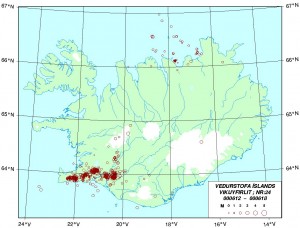
Week 24 of the year 2000. Shows the aftershock pattern after the strong earthquake that year. Copyright of this picture belongs to Icelandic Met Office. It is from there web site.

Week 25 of the year 2000. Shows the evolving aftershock pattern after the second strong earthquake on the SISZ that year. Copyright of this picture belongs to Icelandic Met Office. It is from there web site.
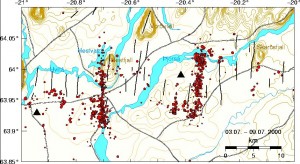
High detail picture of the earthquake activity area in SISZ of the year 2000. Copyright of this picture belongs to Icelandic Met Office. It is from there web site.
Year 2008. On the 29th of May 2008 there was a earthquake with the size of Mw6.3 on the SISZ. It’s location was between Selfoss and Hveragerði towns. Both towns did suffer rather extensive damage following the earthquake, nobody did die and just minor injuries where reported. Before the large earthquake did hit a smaller earthquake with the size of ML3.2 did happen, along with a swarm of smaller earthquakes. Sadly I did miss that earthquake due to a loss of power at my apartment during that time. Lucky for me I did just discover that just before the large Mw6.3 did happen.
This earthquake was felt in Reykjavík and all around south and west Iceland. There are even report it was felt in Ísafjörður town. I did notice it at home as it moved stuff around in my apartment, but it did not knock everything down in my apartment at Hvammstangi town.
Waveform data that I did record of this earthquake.
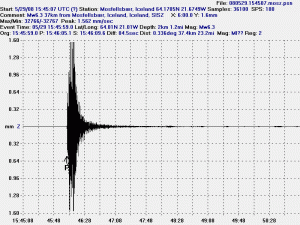
Mosfellsbær geophone that I had connection too in the year 2008 (that station has now stopped operations). The waveform data shows that the station got saturated when the earthquake did happen. This picture is released under Creative Commons Licence (see top link for more details).
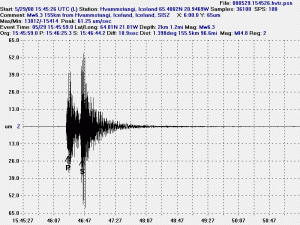
Hvammstangi geophone did record this earthquake clearly. But it did not saturate the geophone like in Mosfellsbær geophone. This picture is released under Creative Commons Licence (see top link for more details).
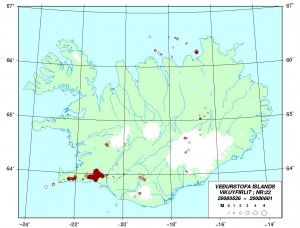
Map of Iceland showing the area of the main activity where the Mw6.3 earthquake did happen and the large view of the aftershocks that did follow it. This is from Week 22 in 2008. Copyright of this picture belongs to Icelandic Met Office. It is from there web site.

Close up map of the activity following this earthquake. The fault line is clear on this map, as the aftershocks arrange them self clearly alongside it. This is from Week 22 in 2008. Copyright of this picture belongs to Icelandic Met Office. It is from there web site.
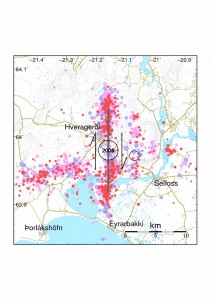
A detailed map of estimated epicentre of the earthquake, the pre-earthquake and how the crust did break up in this area. The fault line was about 12 km long this time around. This is from Week 22 in 2008. Copyright of this picture belongs to Icelandic Met Office. It is from there web site.
Here is a scientific paper on the SISZ 2008 earthquake. With all the details that are important when this type of earthquake happens in Iceland.
This is the short overview of activity in SISZ over the past 1000 years or so. It is clear that SISZ is going to have large earthquakes in the future. But when is always a good question. Like volcanoes it is impossible to know when a large earthquake happens in SISZ. But it is going to happen one day. You can be sure of that.
Reference
Nánar um Suðurlandsskjálftann. (This article is mostly based on this one. It is in Icelandic.)
Suðurlandsskjálfti (Wiki, Icelandic)
2000 Iceland earthquake (Wiki, english)
2008 Iceland earthquake (Wiki, english)
Sigurður Steinþórsson. „Hvenær kemur Suðurlandsskjálftinn?“. Vísindavefurinn 10.4.2003. http://visindavefur.is/?id=3326. (Skoðað 2.4.2011). (Icelandic)
Text updated at 1539 CEST on 3 April 2011. Minor text fixes.
